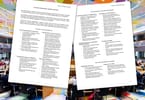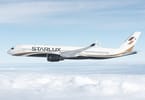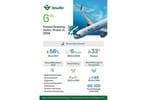Is there not a better tool to judge and benchmark the efficiency of a tourism policy than looking yearly at tourist arrivals data? Each beginning of a year, NTOs are generally getting nervous as numbers on tourists start to come out. But sometimes – and despite strict criteria defined by the World Tourism Organization, UNWTO – countries are willing to change accounting in arrivals for other purposes, generally politics.
A decade ago for example, Cambodia started to integrate into its data bank arrivals at land borders. It was a normal statistical move except that the government started to claim that tourism grew by almost 100 percent in one year. And thus, by comparing arrivals by air with total arrivals over a one-year period, some experts doubt also the veracity of Malaysia’s tourism statistics. Especially with 12.5 million tourists coming from Singapore last year – that would mean that on average, each inhabitant from the city-state comes three times a year as a tourist to Malaysia. Just to remember, a tourist is – in contrary to a visitor – a traveler spending at least an overnight outside its home.
And now it is the turn of the Philippines to juggle with numbers. Presenting arrivals for the year 2009 at the recent ASEAN travel forum, Oscar Palabyab, undersecretary of state at the Philippines Department of Tourism, provided some figures, except that they are incomprehensible. According to data recorded at the top 11 Filipino destinations, the country recorded 5.22 million travelers in 2009 of which 1.13 million were foreign travelers.
“We are very happy about the outcome, as we overpass the five million mark, a growth of 16.7 percent over 2008 when we welcomed 4.47 million tourists in these 11 top destinations,” said M. Palabyab.
The undersecretary was eager to point out that destinations such as Camarines Sur saw tourist arrivals jumping by over 120 percent; Bohol and Palawan enjoyed double-digit growth; and even Cebu and Boracay – the Philippines’ most mature resort destinations – saw arrivals growing respectively by 1.8 percent and 5.3 percent.
It seems that elections are casting a spell over tourism data with Gloria Macapagal Arroyo’s outgoing administration in need of showing a positive tourism outcome. Mixing both domestic and international arrivals and applying it to only some destinations will blur references. Finally people might only remember that over five million of real tourists came to the Philippines – five millions tourists? Coincidence or not, it was the target announced in 2006 by President Arroyo for year 2010.
Sticking to the current released figures, investors interested to go the Philippines might now be deterred by the relatively weak performance of tourism, especially when compared to the reality. Looking at official tourist arrivals in 2008, as recorded by the Philippines National Statistical Coordination Board (NSCB), the country welcomed then 3.14 million foreign tourists. Almost three times more than 2009 international data for the selected 11 destinations! The understate secretary also declared to a reporter from The Pinoy News portal, that domestic tourism generates 16 million tourist arrivals per year. Combining both would then give a total of 19 million tourist arrivals per year.
“In 2009, as we are less exposed than other countries to overseas markets, we finally managed to maintain our shares,” indicated Palabyab. For 2010, the undersecretary of state expects a 5 percent growth in total foreign arrivals.
The Arroyo administration helped in many ways to improve tourism in the country by putting priority on infrastructures. Ports, highways, airports, and new hotels have been built over the last decade, while low-cost airlines have made their way into the Filipino market. A new road was even opened recently to one of the country’s most important tourism destinations, Ifugao rice terraces. The new Baguio-Banaue Road cuts travel from Baguio to Ifugao to just a little over four hours from the old 10-hour travel time. The emergence of new destinations such as Camarines Sur as Asia’s ultimate for wakeboarding, new tourism investments pouring into Boracay, the Subic-Clark Bay area, and in Cebu, Palawan, and in South Manila, a huge entertainment city is taking shape along the Bay, so the Philippines have in reality no reason to feel shy about its tourism future and make up arrivals data.
WHAT TO TAKE AWAY FROM THIS ARTICLE:
- The emergence of new destinations such as Camarines Sur as Asia's ultimate for wakeboarding, new tourism investments pouring into Boracay, the Subic-Clark Bay area, and in Cebu, Palawan, and in South Manila, a huge entertainment city is taking shape along the Bay, so the Philippines have in reality no reason to feel shy about its tourism future and make up arrivals data.
- Sticking to the current released figures, investors interested to go the Philippines might now be deterred by the relatively weak performance of tourism, especially when compared to the reality.
- Presenting arrivals for the year 2009 at the recent ASEAN travel forum, Oscar Palabyab, undersecretary of state at the Philippines Department of Tourism, provided some figures, except that they are incomprehensible.






















